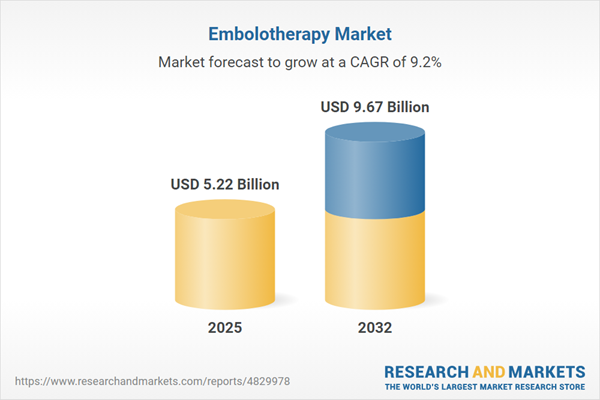Speak directly to the analyst to clarify any post sales queries you may have.
The embolotherapy market is undergoing rapid transformation, driven by sustained innovation in medical devices and steadily increasing clinical adoption. Senior healthcare leaders need clear, strategic analysis to evaluate evolving opportunities and optimize organizational responses to market shifts.
Embolotherapy Market Snapshot 2024–2032
In 2024, the embolotherapy market demonstrated robust growth, advancing from USD 4.79 billion to USD 5.22 billion in 2025. The sector is projected to progress steadily at a CAGR of 9.17%, with growth shaped by advancements in interventional radiology, rising adoption of minimally invasive procedures, and the emergence of next-generation embolic technologies. This favorable outlook is supported by steady expansion in both supply-side innovation and demand from providers seeking efficient patient care solutions. Overall, the market’s positive trajectory positions it as a focus area for strategic investment and operational enhancement over the coming decade.
Scope & Segmentation
- Product Types: Balloons, coils, liquid embolics, particle embolics, and plugs—each offering varied clinical utility depending on the complexity of vascular disorders addressed.
- Application Areas: Neurovascular embolization covers treatments like arteriovenous malformation and cerebral aneurysm, as well as tumor embolization. Peripheral embolization involves arterial and venous interventions, while additional uses include prostate artery embolization, transarterial chemoembolization, transarterial radioembolization, and uterine fibroid embolization.
- End Users: Ambulatory surgical centers, hospitals, and specialty clinics—such as oncology and vascular centers—reflect the wide reach and increasing clinical integration across care environments.
- Regional Coverage: Americas—spanning the United States, Canada, Mexico, Brazil, Argentina, Chile, Colombia, and Peru; Europe, the Middle East & Africa—including the United Kingdom, Germany, France, Russia, Italy, Spain, and a diverse group of regional hubs; and Asia-Pacific, comprising China, India, Japan, Australia, South Korea, Indonesia, Thailand, Malaysia, Singapore, and Taiwan.
- Leading Companies Analyzed: Boston Scientific Corporation, Terumo Corporation, Medtronic plc, Johnson & Johnson, Becton, Dickinson and Company, Penumbra, Inc., Merit Medical Systems, Inc., Cook Medical LLC, MicroVention, Inc., and Asahi Intecc Co., Ltd. form the backbone of competitive activity and product advancement.
Key Takeaways for Senior Decision-Makers
- Embolotherapy is gaining preference over traditional surgery in both vascular and oncology fields, boosting the number of minimally invasive procedures conducted in specialized centers and ambulatory surgical environments.
- Advancements in imaging and device tailoring facilitate patient-specific treatments and enhance procedural safety, contributing to improved clinical outcomes and reduced complication rates.
- New partnerships between device manufacturers, biotechnology firms, and digital health companies are speeding the availability of integrated therapies and novel biomaterials, supporting broader therapeutic options.
- Decentralized clinical models and a shift toward value-based reimbursement increase demand for efficient, cost-effective, and outcome-oriented embolization products among healthcare payers and providers.
- Varied adoption rates and reimbursement structures across global regions underscore the necessity for adapting strategies to local conditions as emerging markets expand interventional capabilities.
Tariff Impact and Supply Chain Adaptations
Upcoming United States tariff adjustments in 2025 are initiating a reconfiguration of global supply chains for embolization products. To manage related risks and respond quickly to new import conditions, manufacturers are implementing dual sourcing strategies, developing regional production capacities, and building strategic alliances. Procurement and pricing models are likewise evolving, with healthcare payers requiring greater transparency and a focus on cost-effectiveness. As regulatory demands shift, operational efficiency and reliable supplier relationships become vital for suppliers and purchasers navigating a changing market environment.
Methodology & Data Sources
The report utilizes a dual-layered approach, combining in-depth secondary analysis of industry datasets, regulatory documents, and clinical research with direct interviews involving clinicians, procurement specialists, and reimbursement advisors. Quantitative data is modeled using triangulation and scenario methods, and all findings undergo expert panel and peer review for validation.
Why This Report Matters
- Enables informed investment and product development strategies by delivering targeted insights into core factors shaping the embolotherapy field.
- Supports executives in risk assessment, supply chain optimization, and market positioning within new and established geographic regions.
- Equips senior leaders with forward-looking perspectives to anticipate evolving clinical and regulatory requirements, preparing organizations for both challenges and growth opportunities.
Conclusion
As embolotherapy evolves in response to innovation and regulatory updates, healthcare executives benefit from clear analytics to guide strategic direction and capitalize on market opportunities amid changing global care delivery models.
Additional Product Information:
- Purchase of this report includes 1 year online access with quarterly updates.
- This report can be updated on request. Please contact our Customer Experience team using the Ask a Question widget on our website.
Table of Contents
3. Executive Summary
4. Market Overview
7. Cumulative Impact of Artificial Intelligence 2025
List of Figures
Samples

LOADING...
Companies Mentioned
The key companies profiled in this Embolotherapy market report include:- Boston Scientific Corporation
- Terumo Corporation
- Medtronic plc
- Johnson & Johnson
- Becton, Dickinson and Company
- Penumbra, Inc.
- Merit Medical Systems, Inc.
- Cook Medical LLC
- MicroVention, Inc.
- Asahi Intecc Co., Ltd.
Table Information
| Report Attribute | Details |
|---|---|
| No. of Pages | 187 |
| Published | October 2025 |
| Forecast Period | 2025 - 2032 |
| Estimated Market Value ( USD | $ 5.22 Billion |
| Forecasted Market Value ( USD | $ 9.67 Billion |
| Compound Annual Growth Rate | 9.1% |
| Regions Covered | Global |
| No. of Companies Mentioned | 11 |









